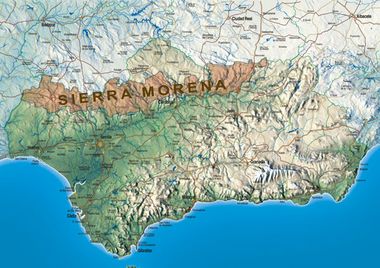
Why choose Sierra Morena for Birdwatching? Seven reasons why birdwatchers want to come to this new and – still – not very often visited destination:
1. First of all, out of its 241 bird species there are many of the jewels of the
Iberian birdlife and Mediterranean species like the Spanish imperial eagle and the black vulture (its main colonies in Andalucía are here), Bonelli’s eagle, booted eagle, short-toed eagle, black kite, lesser kestrel, griffon vulture, bee-eater, orphean warbler,
Sub-alpine warbler, Sardinian warbler, Iberian chiffchaff, white-rumped swift, Alpine swift, pallid swift, little swift, red-necked nightjar, red-billed chuff, black-eared wheatear and black wheatear, blue rock thrush, rock sparrow, Spanish sparrow, red-rumped sparrow, black stork, white stork, European Green woodpecker, azure-winged magpie, great spotted cuckoo, little bustard, Montagu’s harrier, Dartford warbler, thelka lark, hoopoe, common starling, rufous-tailed scrub robin, Western olivaceous warbler, stone curlew, cirl bunting, European turtle dove, red-legged partridge, woodchat shrike, Southern grey shrike, purple swamp hen and the golden oriole. 2. These nature areas are also the habitat of endangered carnivorous species like the Iberian lynx and the Iberian wolf as well as large numbers of deer, fallow deer, mouflons and other mammals. There is an exceptional list of reptiles and amphibians with several exclusive taxa from the Iberian Peninsula and the South-east of Europe. 3. The expert naturalist will also have the opportunity to enjoy the well conserved bat fauna, autochthonous fish and insects (including the dragonfly which is worth a special mention). The flora includes many species associated with a Mediterranean climate and include beautiful wild spring orchids. 4. Additionally you have to keep in mind the fact that Sierra Morena is situated close to other top bird areas like Doñana (only an hour away) and La Serena (also an hour away). As well as being relatively close to interesting places for nature and bird lovers like the Odiel marshes, the Brazo del Este wetlands, the Fuente de Piedra salt lake, the Sierras de Grazalema and Ronda or the lakes and countryside of La Lantejuela-Osuna. A bit further away but still easy to get to you have the Straits of Gibraltar, Sierra Nevada, Almería-Cabo de Gata and the plains of Cáceres-Trujillo. This is why it is easy to plan a visit combining several of these places that have very diverse birdlife and landscapes so the birdwatcher can mark up a long list of birds without moving far. 5. Sierra Morena is well situated for those visitors who stay in the lovely historic cities of Seville, Córdoba, Jaén and Granada, not forgetting Úbeda and Baeza, World Heritage Sites. It is also less than an hour from Seville airport, one hour twenty minutes from Granada-Jaén airport, less than two hours from Málaga-Costa del Sol and two and a half hours from Madrid and Faro-Algarve airports. 6. The whole of Sierra Morena is dotted with lovely small white villages that are typical of Andalucía with an interesting historic-artistic heritage. They offer varied accommodation in hotels, boarding houses, rural accommodation, camp sites and eco-farms. The cuisine is especially good and it is highly appreciated in Spain and abroad, its “pata negra” ham comes from pigs that graze free-range and eat acorns from the oak groves and its olive oil is excellent. 7. Recently Sierra Morena has been recognized as an ideal place for eco-tourism. The emerging business network made up of small local companies – respecting the environment and with all the necessary permits– offers services like guided Birdwatching tours, photographing birds of prey and passeriormes from hides, walks, detecting and sighting lynx and other mammals, identifying mushrooms, cultural and ethnographical tours, Nordic walking, canoeing, horse riding, etc. Internet links for Birdwatching - Access the Bird Guide (Guía de Aves) in Sierra Morena online
- Information on the 62 signposted Birdwatching routes in Sierra Morena, including location and top species
- Books from the collection Routes to see Birds and Nature in Sierra Morena (Rutas para ver Aves y Naturaleza en Sierra Morena) that are a pocket edition to take with you so you don’t miss anything
- The MITO network. A group of companies specialising in Birdwatching holidays in the Sierra Morena, ideal for planning visits to Sierra Morena, including accommodation aimed at bird-watchers and companies dedicated to adventure holidays and eco-tourism offering services linked to Birdwatching, nature photography and walking holidays.
Birdwatching and nature routes in Sierra de Aracena and Picos de Aroche
This very large district is situated at the western frontier of the Sierra Morena in the province of Huelva. In its area of over 300.000 hectares you can find varied Mediterranean landscapes, like rivers with oleanders and broom, tall thick oak woods, large patches of Mediterranean scrub, famous chestnut groves, well conserved riverside forests and extensive meadows that perfectly exemplify what is called today “sustainable use” of resources.
H-1. Vulture country
H-2. The Buervas Valley (Aracena Reservoir)
H-3. Route of Our Lady of the Puerto
H-4. Centenary chestnut trees
H-5. Teuler mines
H-6. Through the oak groves in Huelva province
H-7. Aracena Castle
H-8. The Cala riverside
H-9. Frontier birds
H-10. Meadows of the Sillo river and the Celtic settlement of Capote
H-11. Chorros de Ollarancos waterfall
H-12. Family friendly: The source of the river Odiel
H-13. River Múrtigas and the Torres valley
H-14. Plains of Gracia
H-15. Las Peñuelas
H-16. Cala Castle
H-17. Banks of the Alca-laboza Birdwatching and nature routes in Sierra Morena in the
province of Seville Few visitors imagine that at such a short distance from the Giralda tower there is such an extraordinary district, a perfect mixture between the wild and rouge side of the eastern Sierra Morena and the luxuriant beauty of the riparian forest on the banks of the Huéznar river which cuts through the western part of the mountains.
SE-1. Viar Valley
SE-2. La Senda trail
SE-3. Onza mountains and the river Bembézar
SE-4. Las suertes del Guadalbacar river
SE-5. A wood in stone
SE-6. The riverside woods of the Ciudadeja
SE-7. Along the banks of the Huéznar river
SE-8. Los Covachos
SE-9. The riverside meadows of the Cala
SE-10. Eagle country
SE-11. Family friendly: El Venero
SE-12. The Viar Canyon
SE-13. Melonares bridge
SE-14. El Galeón
SE-15. Retortillo reservoir Birdwatching and nature routes in the Sierra Morena in the province of Córdoba As unknown as it is interesting, this part of the Sierra Morena in the province of Córdoba watches over the monumental city of the Mosque from on high. Between the deep ravines of the Retortillo river and the emblematic Yeguas valley, a never-ending string of mountains, crags and rivers spread out with their rich natural treasures.
CO-1. Sierra de Hornachuelos
CO-2. Guadalmellato
CO-3. Guadalora Stream
CO-4. Névalo Castle
CO-5. Cliffs of Sierra del Castillo
CO-6. Los Ángeles trekking trail
CO-7. Uncommon commonland
CO-8. El Valle
CO-9. Cabeza Aguda pine grove
CO-10. Film scenery
CO-11. Family friendly: La Rabilarga walk
CO-12. Guadalquivir river
CO-13. Guadiato ravines
CO-14. Slopes of the Guadalbarbo
CO-15. The Station Routes through the Sierra Morena in the province of Jaén The Despeñaperros mountain pass is always open to travellers who want to go deep into the Sierra Morena in the province of Jaén. Thousands of acres of Mediterranean forest are waiting for you there, holm and cork oaks, extensive pine groves, rivers speckled with oleanders and dense riverside woods, mountains and hills dotted with granite rocks and rocky ravines, meadows where fighting bulls graze, countryside with silver olive groves and fertile valleys irrigated by the great Guadalquivir river. J-1. Miner birds
J-2. Valdeazores Ravine
J-3. Foothills of the Sierra Morena
J-4. The Jándula river’s farewell
J-5. Land of lynxes
J-6. El Rey vantage point
J-7. La Cimbarra waterfalls
J-8. Mount Burguillos
J-9. Family friendly: La Pasada del Castaño
J-10. Family friendly: la Campana river (La Aliseda)
J-11. La Lancha
J-12. Peñón Jurado and Las Tres Hermanas
J-13. Birds n the open countryside
J-14. Bury al-Hammam
J-15. The banks of the Guadalquivir river
|

